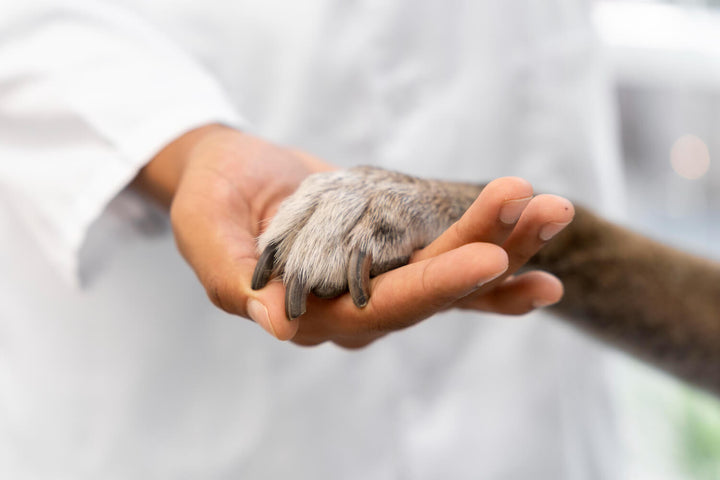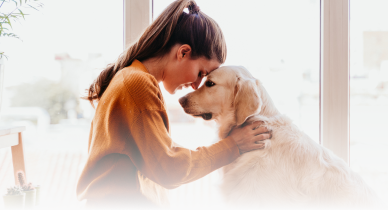The Boxer: A Spirited Companion with a Heart of Gold
Did You Know these Facts about the Boxer?
-
Did you know that Boxers can trace their ancestry back to ancient Greece? These magnificent dogs are descendants of the Molossian Hound, a breed known for its strength and agility.
-
Boxers are renowned for their athleticism. Not only are they excellent at traditional canine sports like agility and obedience, but they have also excelled in roles as diverse as police work, military service, and even as guide dogs.
-
With their distinctive wrinkled foreheads and soulful eyes, Boxers are masters of non-verbal communication. Their expressive faces can convey joy, curiosity, and sometimes a mischievous streak.
-
Boxers are often referred to as "gentle giants." Despite their muscular build, they are exceptionally patient and protective when it comes to family, especially children. They make wonderful playmates.
- One of the most endearing traits of Boxers is their joyful "wiggle." When they're excited (which is quite often), their entire bodies wiggle with excitement. It's an irresistible display of happiness.
The Boxer ranks as one of the most popular dog breeds in the United States, consistently ranking high on every list. In 2022 they grabbed the #16 position in the AKC's popularity list. . Their affectionate nature, boundless energy, and loyalty have captured the hearts of countless families, making them a beloved choice for both singles and households alike.

Traits of the Boxer Breed
Overall Personality. Boxers are known for their exuberance and affection. They are intelligent, alert, and playful, making them excellent companions for active individuals and families. This breed is highly social and thrives on human interaction, often forming deep bonds with their owners. They are protective and courageous, making them good watchdogs, yet their friendly disposition ensures they're more likely to greet strangers with a wagging tail than aggression.
Family Life. In a family setting, Boxers shine. They are patient and gentle with children, often assuming a role as a loyal and loving playmate. Their high energy levels make them fantastic for families who enjoy outdoor activities and playtime.
Physical Appearance. Boxers have a distinctive appearance. They are medium to large dogs with a strong, muscular build. Their short, shiny coat comes in various colors, including fawn (tan with a black mask) and brindle (stripes on a fawn background). Boxers also have a square-shaped head with a short, broad skull, and a characteristic undershot bite, which gives them their unique expression.
Sociability. Boxers thrive on social interaction. They're known for their boundless enthusiasm and are usually the life of the party. Whether it's a family gathering or a day at the park, Boxers are happiest when they're around people and other dogs.
Average Sizes & Life Expectancy
- Height: 21 to 25 inches tall (53 to 63 cm)
- Weight: 55 to 70 pounds (25 to 32 kg)
- Life Expectancy: Around 10 to 12 years
Detailed Description of the Boxer Breed
The Boxer is a breed that exudes charisma, strength, and an irresistible sense of joy. Their fascinating history, striking physical appearance, and remarkable personality traits make them one of the most beloved canine companions in the world. In this detailed exploration of the Boxer breed, we'll dive deep into every aspect, from their physical attributes to their presence in history and pop culture.
Physical Appearance. Boxers are known for their athletic, muscular build. They have a square-shaped head with a short, broad skull. The most distinctive feature of their face is their undershot bite, which gives them an endearing and unique expression. Their eyes are dark and soulful, exuding intelligence and curiosity. Ears can be natural or cropped, standing erect when uncropped. Their short, shiny coat comes in various colors, with fawn (tan with a black mask) and brindle (stripes on a fawn background) being the most common.
This breed's physique is a testament to their versatility. Their strong legs and chest give them the power and stamina needed for activities like agility and endurance. Boxers are muscular but agile, making them excellent athletes.
Temperament and Personality. Boxers are often described as "gentle giants." They possess an unwavering loyalty to their families and are known for their affectionate nature. Despite their strong appearance, they are playful, energetic, and thrive on human interaction. They have an innate sense of protectiveness, making them excellent watchdogs. Boxers are courageous, and while they will defend their loved ones, they typically greet strangers with curiosity and friendliness.
Adaptability. One of the Boxer's most remarkable traits is their adaptability. They can thrive in various environments, from bustling city apartments to spacious suburban homes. However, they do require regular exercise and mental stimulation to keep their boundless energy in check. A Boxer's adaptable nature makes them suitable for different lifestyles, as long as they receive the love and attention they crave.
Care Guidelines. Boxers require regular exercise to stay healthy and happy. Daily walks, playtime, and interactive toys can help burn off their energy. Their short coat is low-maintenance and only requires regular brushing to keep it shiny. Be sure to clean their ears regularly to prevent infections.
Diet: A balanced diet is crucial for Boxers to maintain their muscular build. Consult with a veterinarian to determine the best diet for your specific Boxer's needs.
Training Strategies. Boxers are intelligent and eager to please, which makes training relatively straightforward. However, they can be a bit stubborn, so consistency and positive reinforcement are key. Early socialization is crucial to ensure they grow up to be well-mannered adults.
Notable in History and Pop Culture. Boxers have a rich history, and their name originates from their tendency to playfully "box" with their front paws. They were developed in Germany in the late 19th century, initially as hunting dogs. Over the years, they found success in various roles, including police work and as loyal family pets.
In pop culture, Boxers have made their mark. The iconic Boxer dog named "Max" appeared alongside Jim Carrey in the movie "The Mask." They've also graced the covers of magazines and have become internet sensations with their heartwarming videos.
What to expect when living with the Boxer Breed
Personality. Boxers are known for their playful and energetic personalities. They are incredibly affectionate and bond closely with their families, often being referred to as "velcro dogs" for their tendency to stick by their owner's side. This breed thrives in active households where they can be part of the action. They are great with children and can make wonderful family pets.
Ideal Environment. Their boundless energy requires regular exercise and mental stimulation. A bored Boxer can become destructive, so it's essential to provide them with activities that challenge their intelligence. Long walks, runs, and interactive play sessions are all essential for keeping your Boxer happy and healthy.
Maintenance Level. Boxers are known for their clean and minimal-shedding coats, but they do require regular grooming to keep them looking their best. Weekly brushing will help keep their coat in good condition and minimize shedding. They are sensitive to extreme temperatures, so it's essential to keep them cool in hot weather and provide them with warm bedding in cold climates.
Overall Health Expectations and Best Health Tests for the Boxer Breed
Health Considerations. While Boxers are generally healthy dogs, they are prone to some breed-specific health issues. One of the most common concerns is a heart condition called dilated cardiomyopathy (DCM). Regular veterinary check-ups, including heart screenings, can help detect and manage this condition.
Boxers can also be susceptible to hip dysplasia and certain types of cancer. To ensure the best possible health for your Boxer, it's crucial to maintain a balanced diet and provide regular exercise to keep their weight in check, which can help reduce the risk of hip dysplasia.
Recommended Health Tests. Routine health tests recommended for Boxers include cardiac evaluations, hip and elbow evaluations, and genetic testing for certain conditions. Regular visits to the veterinarian are essential to catch and address health issues early. Responsible breeding practices can also help reduce the prevalence of genetic conditions in this breed.
Best Nutrition, Diet & Supplements for the Boxer Breed
Nutrition and Diet. This breed is known for its high energy levels, muscular build, and active lifestyle, which means their dietary needs are specific.
Boxers require a diet rich in high-quality protein to support their muscle development and overall vitality. Look for dog food with a protein source like chicken, beef, or fish listed as the primary ingredient.
Omega-3 and Omega-6 fatty acids are essential for maintaining your Boxer's skin and coat health. These fatty acids can be found in ingredients like fish oil and flaxseed. They also help reduce inflammation, which can be beneficial for dogs prone to certain health conditions.
While protein is vital, don't overlook the importance of carbohydrates. Carbs provide the energy Boxers need for their active lifestyle. Look for dog food that includes complex carbohydrates like sweet potatoes, brown rice, and peas.
Hydration is Key. Ensure your Boxer always has access to fresh, clean water. Proper hydration is vital for digestion, temperature regulation, and overall vitality.
Supplements. Some Boxers may benefit from supplements, particularly those that support joint health. Glucosamine and chondroitin supplements can help maintain healthy joints, reducing the risk of hip dysplasia. Always consult your veterinarian before adding supplements to your dog's diet to ensure they are appropriate for your individual pet.
Foods to Avoid. Steer clear of dog foods that contain excessive fillers like corn, soy, and wheat. These ingredients provide little nutritional value and can lead to digestive issues. Establish a regular feeding schedule for your Boxer to help with weight management. Divide their daily portion into two meals to prevent overeating and reduce the risk of bloat, a condition to which this breed can be prone.
Grooming Requirements for the Boxer Breed
Coat Maintenance and Shedding. Boxers have a sleek, smooth coat that doesn't require extensive grooming. Regular brushing with a soft-bristle brush can help remove loose hair and distribute the skin's natural oils. This can also minimize shedding, which, though not excessive, does occur year-round. Brushing a few times a week is usually sufficient.
Paw Care and Hygiene. Pay attention to your Boxer's paws, especially if they are active outdoors. Check for any cuts, foreign objects, or signs of infection. Keeping their paws clean and inspecting them regularly can help prevent issues.
Ear cleaning. Due to their floppy ears, Boxers can be prone to ear infections. Clean their ears regularly with a vet-recommended solution to prevent wax buildup and infection. Always be gentle and avoid inserting anything deep into the ear canal.
Bathing Frequency. Boxers are relatively clean dogs and typically don't require frequent baths. Bathing every two to three months or when they get dirty is usually enough. Be sure to use a dog-specific shampoo to avoid skin irritation.
Exercise Required for the Boxer Breed
Boxers thrive on physical activity. Aim for at least an hour of exercise each day. This can include brisk walks, jogging, or off-leash play in a secure area. They enjoy activities like fetch and agility training.
In addition to physical exercise, Boxers require mental stimulation to prevent boredom. Puzzle toys, obedience training, and interactive games can engage their minds.
Boxers do best with a consistent exercise routine. Regular play and physical activity help prevent obesity and maintain muscle tone. These are social dogs and enjoy the company of their human family. Engage in activities like fetch, frisbee, or even dog sports like agility to keep them engaged and happy.
Training Tips for the Boxer Breed
Boxers are intelligent and eager to please, making them relatively easy to train. However, they can be a bit stubborn at times, so it's essential to approach training with consistency, patience, and positive reinforcement.
Do…
- Begin training your Boxer as a puppy. Early socialization and basic obedience training are crucial to ensure they grow into well-behaved adults.
- Use positive reinforcement techniques such as treats, praise, and play to motivate your Boxer. They respond well to rewards and will repeat behaviors that earn them praise and treats.
- Be consistent with your commands and expectations. Use the same cues for specific behaviors and ensure everyone in the household follows the same training guidelines.
- Socialize your Boxer with various people, animals, and environments from a young age. This helps them become well-adjusted adults and reduces the risk of aggression or fear-based behaviors.
Don't…
- Be too harsh. Boxers are sensitive and can become fearful or anxious if subjected to harsh training methods. Avoid yelling or physical punishments.
The Boxer Breed is Suitable For
Boxers thrive in homes with active lifestyles. They love outdoor activities, so access to a yard or nearby parks is ideal. They make excellent companions for runners, hikers, and those who enjoy long walks.
They are known for their affection toward children. They are generally gentle and protective, making them great family dogs. However, their exuberance can sometimes be too much for very young children, so supervision is essential. Boxers are social animals and tend to get along well with other dogs. Early socialization is crucial to ensure they interact positively with other pets. However, their strong prey drive may make them unsuitable for homes with small animals like rabbits or guinea pigs.
While Boxers can adapt to apartment living, it's important to note that they require ample exercise. Owners in apartments must commit to daily walks and playtime to keep their Boxer happy and healthy.
The Boxer Breed is Not Suitable For
Boxers are highly active and energetic. If you lead a sedentary lifestyle and are not prepared to provide them with regular exercise and mental stimulation, this breed may not be suitable for you.
Extremely cramped living quarters, such as tiny apartments with no outdoor access, may not be the best environment for Boxers. They need space to move around and burn off energy.
While Boxers are generally good with children, their exuberance can sometimes be too much for very young or fragile kids. In such cases, a more docile breed might be a better choice. They also have a strong prey drive, which can make them unsuitable for homes with small animals like rabbits, birds, or hamsters.
Famous Boxer Owners
George Clooney - The Hollywood actor and director George Clooney is known for his love of Boxers. He had a beloved Boxer named Max, who was his loyal companion for many years. Max even made appearances in some of Clooney's films.
Justin Timberlake - The singer and actor Justin Timberlake is another Boxer enthusiast. He had two Boxers named Buckley and Brennan. Timberlake often shared photos of his beloved dogs on social media, showcasing the strong bond between him and his pets.
Humphrey Bogart and Lauren Bacall - This iconic Hollywood couple had a Boxer named Harvey. Harvey appeared alongside Bogart and Bacall in several films, making him one of the most famous canine actors of his time.
Accomplishments of the Boxer Breed
Boxers have served as search and rescue dogs, police dogs, and even as military dogs. Their intelligence, strength, and loyalty make them excellent choices for these critical roles.
The breed's name itself, "Boxer," reflects their history as skilled hunters and fighters. Boxers have been used as mascots for boxing events and clubs due to their strong and athletic appearance. Boxers excel in various canine sports, including agility, obedience, and tracking. Their agility and willingness to learn make them top contenders in these competitions.
Boxers have appeared in various movies and television shows. Notable examples include the film "Homeward Bound: The Incredible Journey" and the TV series "The Littlest Hobo." Their expressive faces and dynamic personalities make them popular choices for entertainment.
Some Boxers have achieved remarkable records. For example, a Boxer named Brandy holds the Guinness World Record for the "longest jump by a dog into water" at an astonishing 27.5 feet.
Their versatility, intelligence, and natural athleticism have made them stars in various fields, earning them a special place in the hearts of many.

The History of the Boxer Breed
Creation and Purpose. Boxers are descendants of the now-extinct Bullenbeisser and the English Bulldog. The Bullenbeisser was a powerful and agile hunting dog used for tracking and holding large game such as boars, bears, and deer. Crossbreeding Bullenbeissers with Bulldogs was the first step in creating the Boxer. This cross aimed to retain the strength and tenacity of the Bullenbeisser while infusing the more compact and brachycephalic traits of the Bulldog.
The primary purpose of this breeding was to create a versatile working dog that could excel in hunting, particularly for boar and bear, while also serving as a capable guardian and protector. This new breed had to be agile, fearless, and powerful—a true multipurpose dog.
Early Roles and Evolution. Over time, breeders refined the Boxer's characteristics. They emphasized traits like a strong jaw, stocky build, and distinctive brachycephalic head. This selective breeding resulted in the breed we recognize today.
Boxers began their journey as working dogs but soon transitioned to other roles. They became popular police dogs, serving alongside law enforcement officers. Their intelligence and trainability made them exceptional search and rescue dogs.
During World War I, Boxers were employed as messenger dogs, guard dogs, and even as pack carriers. Their loyalty and courage earned them recognition for their wartime contributions.
Changes and Modern Impact. In the post-war period, Boxers began to gain popularity as family dogs due to their affectionate and protective nature. They soon became beloved companions in households worldwide.
Today, Boxers continue to excel in various roles, including therapy dogs, service dogs, and, of course, as cherished family pets. Their rich history as versatile working dogs has left a lasting legacy, making them one of the most adored and respected breeds in the canine world. Their journey from skilled hunters to loyal companions is a testament to their adaptability and enduring appeal.
The Boxer Breed Standard
The Boxer breed falls under the Working Group category according to the American Kennel Club (AKC). This classification highlights the breed's strong work ethic, intelligence, and physical prowess. Boxers have a history of performing various tasks, including working as hunting dogs, guard dogs, and even serving in the military.
The AKC's formal Breed Standard for Boxers outlines the ideal characteristics for the breed. According to this standard, Boxers are medium-sized dogs with a strong, muscular build. Their head is distinctive, with a short, blunt muzzle and a strong underbite. They have a sleek, shiny coat that comes in various colors, with fawn and brindle being the most common. The breed standard emphasizes their alert, intelligent, and confident expression.
The American Boxer Club (ABC) is the national breed club for Boxers in the United States. They are dedicated to promoting and preserving the integrity of the breed. You can find more information about Boxers, breed standards, events, and resources on their website: American Boxer Club.
General Appearance
Head, Muzzle, Nose. Boxers are known for their distinctive head, which is broad and slightly wrinkled. The skull is in proportion to the body, and the forehead is moderately arched. Their expressive dark eyes are alert and set well apart, giving them an intelligent and friendly gaze. The ears are high-set, either cropped or left natural, and fold forward. Boxers have a short and square-shaped muzzle, contributing to their unique facial expression. The Boxer's muzzle is blunt and deep, with a distinct stop. Their nose is broad and black, providing excellent olfactory abilities. This feature makes them efficient tracking dogs.
Teeth. Boxers have a strong and powerful bite with a well-defined underbite, where the lower teeth protrude slightly ahead of the upper teeth. This characteristic bite is advantageous for gripping and holding onto objects, a skill that originated from their working heritage.
Neck. Their neck is muscular, slightly arched, and free from excessive skin folds. It blends smoothly into their well-constructed body, allowing for both strength and agility.
Body. Boxers boast a well-proportioned and athletic body. They have a deep, broad chest that provides ample room for lung capacity, making them excellent runners. Their back is short and straight, leading to a strong and slightly arched loin. Boxers' ribs are well-sprung, contributing to their impressive stamina and vitality.
Tail. The Boxer's tail is set high and carried erect. In some regions, tail docking is a common practice, resulting in a short tail that complements their overall appearance. In countries where tail docking is prohibited, Boxers may have a natural tail that is high-set and tapers to a point.
Coat. Boxers have a short, smooth, and close-lying coat. Their coat is shiny and lies tightly against their skin, which not only adds to their sleek appearance but also makes grooming relatively easy. Boxers come in various colors, with fawn and brindle being the most common. Fawn Boxers have a solid golden tan coat with a black mask, while brindle Boxers have a striped pattern of fawn and black stripes.
Size. Boxers are a medium-sized breed. Adult males typically stand between 23 to 25 inches (58 to 63.5 cm) at the shoulder and weigh around 65 to 80 pounds (29.5 to 36.3 kg). Adult females are slightly smaller, standing between 21.5 to 23.5 inches (54.5 to 59.7 cm) and weighing around 50 to 65 pounds (22.7 to 29.5 kg).
Gait. The Boxer's gait is one of their distinctive features. They have a powerful and balanced movement, covering the ground with grace and efficiency. Their stride is free and ground-covering, reflecting their athleticism and agility. As they move, their powerful hindquarters provide the drive necessary for agility and speed, while their front legs maintain a straight, forward-reaching motion.
Reputable Breeders
For those seeking a well-bred Boxer there are reputable breeders who prioritize health, temperament, and the breed's standard. Here are a few notable breeders:
Top Shelters for Adoption
Adopting a dog can be a rewarding experience. Here are five shelters where you might find a Boxer in need of a loving home:
Top 5 Frequently Asked Questions & Answers about the Boxer Breed
How big do Boxers get?
Male Boxers typically weigh between 65 to 80 pounds, while females usually weigh between 50 to 65 pounds.
Are Boxers good with children?
Yes, Boxers are known for their affectionate and protective nature, making them great family pets.
Do Boxers require a lot of exercise?
Yes, Boxers are an active breed and need regular exercise to stay healthy and happy. Daily walks and playtime are essential.
Are Boxers prone to specific health issues?
Yes, Boxers can be prone to certain health concerns, including hip dysplasia, heart issues, and some types of cancers.
Do Boxers make good guard dogs?
Yes, Boxers are excellent guard dogs. They are alert, loyal, and protective of their families.
A Final Tip for Bringing a Boxer into Your Life
Bringing a Boxer into your life means welcoming a loyal, intelligent, and affectionate companion. These dogs thrive on human interaction and make excellent family pets. With proper training, socialization, and exercise, Boxers can be a joyful addition to your household. Their boundless energy and loving nature will keep you entertained and provide you with years of cherished memories.
Valuable Resources for Your Journey to Parenting a Boxer
At Felicitails you will find many wonderful services, supplies and guides for your life ahead with a loving pup at your side.

Hope You Enjoyed The Read!
Tag Cloud

A warm welcome from Lindsay & Huck (my English Pointer). Hope you enjoy the read and find just what you are looking for when it comes to living your best life with your loved pets.

-
Dog Breeds
(42)
-
Emotional Support Animals
(10)
-
Dog Grooming
(6)
-
Dog Health
(18)
-
Life with a Dog
(18)
-
Dog Nutrition
(11)
-
Service Animals
(11)
-
Dog Training
(5)






